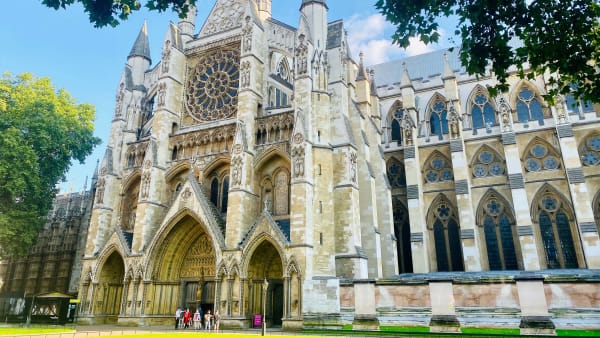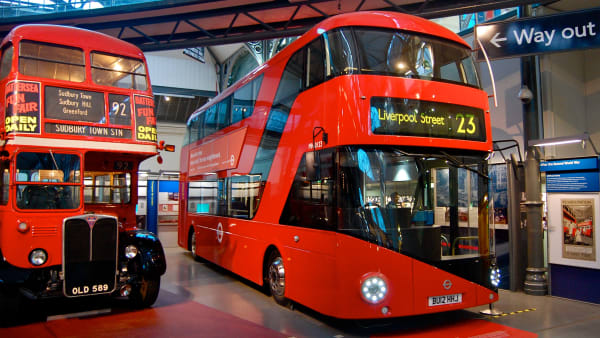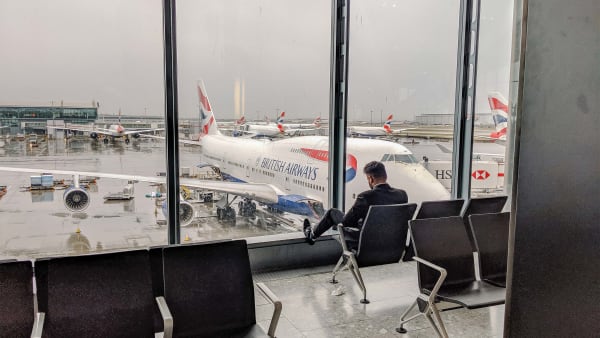Getting around in London
Getting a clear idea of the available transport options and the extensive transport network is essential in navigating the city during your stay in London.
Getting around in London
Getting a clear idea of the available transport options and the extensive transport network is essential in navigating the city during your stay in London.
Considering London’s size and distances, some people might think moving around the city can be quite difficult, but that is far from the truth. Luckily for everyone, London has an appropriately-extended public transport network. The network includes the Underground (made up of Tube, DLR and Overground), urban buses, and National Rail trains in London.
The most used forms of transport are the Tube and buses, so it’s exactly these that you’ll be using the most to get around London as a tourist. You will find that moving around the city by public transport is the easiest way to reach your destination and that having a car is absolutely not necessary.

Different lines and routes intersect often and the ticket system is completely integrated, making it extremely easy to use different means of transport in conjunction with one another.
You do, however, need to be careful about the big crowd, especially at peak hours. Millions of people use public transport every day. As a result, trains and buses can get very busy. Missing a stop or having your things stolen becomes easier at those times.
This is something to be particularly careful about if you’re in London with larger groups or young children. The best way to travel around London as a family is to avoid peak times and know exactly where you are going before boarding a train or bus. This way you’ll avoid losing members to a crowd or having the distraction of trying to figure out your route on the go.
Zone system
The majority of the passes and journey fares for London transport are priced according to the zone system. There are a total of 9 zones throughout which London public transport operates. The areas where you will travel most of the time are zones 1 and 2, the most central ones. This is also where you can find almost all of London’s attractions and monuments.
Now, while the zone system serves to price tickets and passes for the entire London Rails and Underground network (which includes the Tube, the DLR, and Overground), London buses do not respond to this zone system in terms of pricing. Even though they operate everywhere in London, bus journeys always cost the same. It also means that if you have a pass valid for zones 1-2, you can take a bus no matter where you are in London.
Peak/off-peak hours in London
Some public transport journeys in London cost more during peak hours and less during off-peak hours.
Peak hours are Monday to Friday from 6:30 am to 9:30 am, and from 4:00 pm to 7:00 pm. Off-peak hours are all other times. Additionally, if you travel from a station outside Zone 1 to a station within Zone 1, from 4:00 pm to 7:00 pm (even Monday to Friday), that is also considered off-peak.
Underground
The London Underground is London’s rapid transit system, which includes actual underground trains (the Tube, with 12 lines), the DLR, and the London Overground trains.
The Underground - the Tube in particular - is the main way of getting around the city for many. The extension, speed, availability, and reliability of the service, make it the quickest way to reach places in London.

The Tube normally runs between 5:00 am and midnight, with a train frequency of around 3-4 minutes at peak hours (especially in the city centre). At other times you can expect a train every 10 minutes or so.
To go on the Underground, you can use a Travelcard, Oyster, contactless payment method, or single-journey ticket. The fares are calculated on the basis of travel zones and peak/off-peak hours. You can see all prices in the section about Transport passes.
If you’d like to know more about the London Tube, check out our dedicated article.
Buses
Buses are the cheapest form of transport in London and you will find a stop almost everywhere in the city, even in areas where the Underground does not reach or has far-apart stops. Out of the total 700 lines, many run 24/7, while others are replaced by nighttime lines after 10:00 pm. This makes urban buses a great way to move about London without using the Tube if for whatever reason it is unavailable or you want to avoid it.
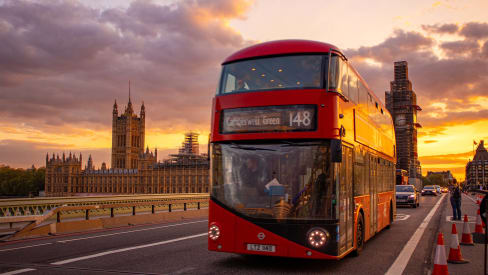
Bus frequency is around 7-15 minutes for high-frequency routes and 15-40 minutes for low-frequency routes (generally in more peripheral areas and at off-peak hours).
There are four ways to pay for a bus journey in London: with a Travelcard, a Bus and Tram Pass, an Oyster, or a contactless payment method. You cannot pay for London buses in cash. A single journey on the bus always costs £1.75, no matter where or at what time you travel in the city.
To know more about London buses, read our dedicated article.
Transport passes
You have probably already heard about the Oyster card even if you haven’t been to London. However, it isn’t the only option available to use public transport.
There are essentially two ways to pay for your London transport journeys. One is to pay as you go and the other is to have an unlimited pass for a fixed price. The transport passes that allow you to travel so are the Travelcard, the Oyster card, and contactless payment methods.
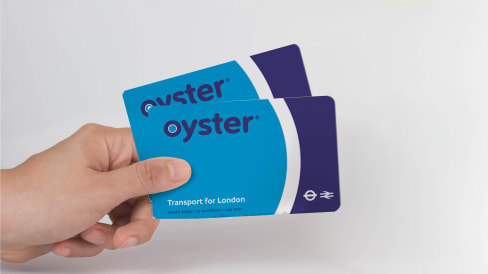
Additionally, there also are paper-printed single-journey tickets available, but they are not commonly used. This is because they are incredibly expensive compared to other options (£6.70 for an adult ticket) and they are only valid for the Underground.
On the other hand, all other passes and cards (Travelcards, Oyster cards, contactless payment methods) can be used on the Underground (which includes the Tube, DLR and Overground), all London buses, and National Rail trains in London.
A Travelcard is a subscription that allows unlimited use within a limited period of time and area. A contactless payment method is whatever bank card or mobile device that supports contactless payment, which you can use to pay as you go for your journeys.
Oyster cards, instead, are plastic cards where you can load both subscription plans and credit for pay-as-you-go travel.
So, do you need an Oyster card in London? If you want to use a Travelcard, then yes, you need an Oyster. If you want to pay as you go, the Oyster is not the only available option. In the following paragraphs, we’ll explain the price differences and you can choose which option you prefer best.
The cost of a Travelcard is determined by its duration (1 day, 7 days, 1 month, or 1 year) and validity throughout London zones (1-2 through 1-9). The 1-day Travelcard, which is printed on a paper ticket, is rather expensive (£15.20), so we don’t recommend it. On the other hand, you will find that the 7-day zones 1-2 Travelcard, which costs £40.70, is extremely convenient.
In the table below are all Travelcard prices for the inner city (zones 1-2).
| Duration |
|---|
| Zones 1-2 |
| Duration | 1 day | 7-day | 1 month | 1 year |
|---|---|---|---|---|
| Zones 1-2 | £15.20 | £40.70 | £156.30 | £1,628.00 |
Now, in terms of pay-as-you-go travelling, Oyster cards and contactless payment methods share the same fares, which are determined by zone validity and peak/off-peak hour usage. You only have to keep in mind that an Oyster card has a printing cost of £7.00, which is non-refundable.
In zone 1 pay-as-you-go journey fares are £2.80 (for peak hours) and £2.70 (for off-peak hours). For travel between zones 1 and 2, the cost is £3.40 (at peak hours) and £2.80 (for off-peak hours).
The Oyster card and contactless payment methods also have daily caps (£8.10 for zones 1-2). This means that you can travel as much as you want on London transport and you won’t be charged over the cap. Contactless payment methods also have a weekly cap (£40.70 for zones 1-2), while Oyster cards don’t.
This pricing system based on zones and peak/off-peak hours does not apply to bus journeys, which always cost £1.75 each and have a daily cap of £5.25 (valid only if you travel on buses exclusively).
You can see a summary of the pay-as-you-go fares and caps in the following tables.
| Pay as you go fares |
|---|
| Hours |
| Zone 1 |
| Zone 1-2 |
| Pay as you go fares | Bus | London Underground network | London Underground network |
|---|---|---|---|
| Hours | All hours | Peak hours | Off-peak |
| Zone 1 | £1.75 | £2.80 | £2.70 |
| Zone 1-2 | £1.75 | £3.40 | £2.80 |
| Pay-as-you-go caps |
|---|
| Zone 1-2 |
| Pay-as-you-go caps | Bus only cap (1-day) | Daily cap(Oyster & contactless) | Weekly cap(only contactless) |
|---|---|---|---|
| Zone 1-2 | £5.25 | £8.10 | £40.70 |
What is the cheapest way to get around London?
The cheapest way to travel around London depends on how long you are staying and on the kind of bank account you have.
Firstly, if your bank account is from outside of the UK, you need to know if you will be charged high conversion rates from your currency to British pound. If the answer is yes, then you should not use contactless payment methods.
In this case, having an Oyster card with pay-as-you-go (if you are staying for 5 days or less) or loaded with a 7-day Travelcard (if you are staying for 6 days or more) is way cheaper.
If you are sure there are no extra currency exchange fees, then you can use a contactless payment method for a stay of 1-5 days in London. If you are staying for 6-7 days, you will need to look at the exact days of your visit.
This is due to the fact that the weekly cap on contactless applies only from Monday to Sunday, while the 7-day Travelcard applies to 7 consecutive days, even if they are not Monday to Sunday.
Therefore, if you are in London during the course of a calendar week, use a contactless payment method. If you are staying between calendar weeks, you have to get an Oyster card and load it with a 7-day Travelcard.
So let’s say you are staying in London for 3 days. The best way to travel is to pay as you go with an Oyster card or a contactless payment method. If you have no conversion fees from your bank, use contactless. If you have high conversion fees, go with an Oyster card.
However, if you’re staying just for a day, the Oyster might not be worth it even if you have high conversion fees. This is because Oyster cards have an initial printing cost of £7.00 that is non-refundable and that doesn’t contribute to your travel credit.
Finally, due to its elevated price, a 1-day Travelcard is never worth its cost. Below you can find a comparison table of Travelcards and pay-as-you-go travelling.
| CardDuration |
|---|
| 1-2 |
| CardDuration | 1 day Travelcard | 1-day cap on pay-as-you-go | 7-day Travelcard | 1-week cap on pay-as-you-go |
|---|---|---|---|---|
| 1-2 | £15.20 | £8.10 | £40.70 | £40.70 |










